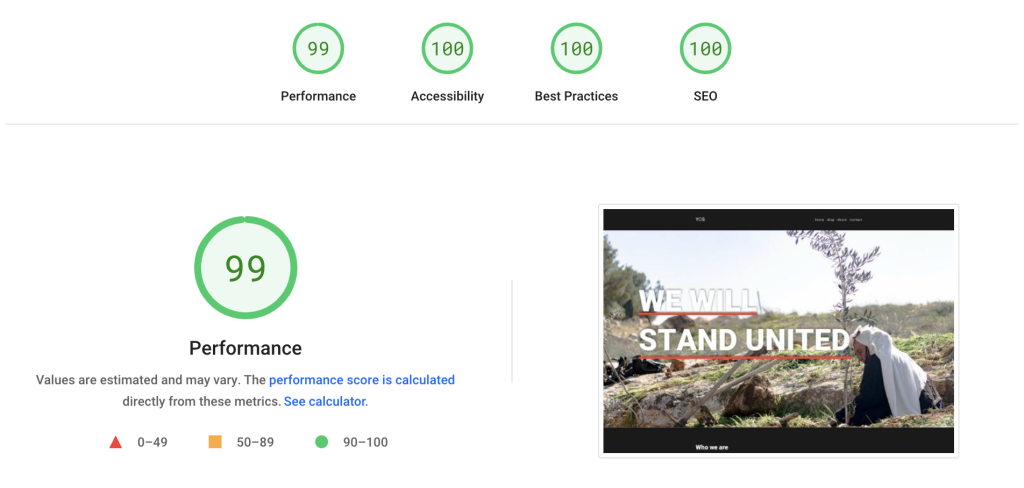GSC supports the grassroots in Palestine with tech development
The Good Shepherd Collective continues to evolve to meet the needs of the movement for Palestinian liberation. From protective presence in communities and planting olives to developing advocacy initiatives and local organizing, we work directly with local Palestinian groups resisting Israeli settler-colonialism and apartheid. Supporting in tangible ways means being physically present, providing legal and political analysis, facilitating financial support, and overcoming often overlooked obstacles in movement work such as technology development.
Having a digital presence is absolutely critical when advancing a movement of liberation. Millions of Palestinians and the solidarity movement around them turn to social media channels every day to advocate for a free Palestine. They use these tools to highlight the mechanisms of Israeli ethnic cleansing. But with Facebook, Twitter, and TikTok censoring critical voices, individuals and political formations in Palestine must develop their digital organizing tools, such as websites for international organizing and advocacy. However, when Palestinians are facing eviction, having their homes demolished, their children imprisoned and killed — community organizers who are on the front lines confronting Israeli violence simply don’t have the additional capacity to develop and optimize websites, deal with security and monitoring concerns, or have the programming background fix problems when they arise. The Good Shepherd Collective is stepping in to fill this need.
Without a website, local groups lose the ability to fully represent themselves. There is not a static, consistent space for them to tell their unique stories or outline the ways solidarity groups can contribute directly in meaningful ways. For example, Facebook, Twitter, and TikTok don’t offer options to build email lists, book tours, and webinars, or the infrastructure to collect online donations. These are all fundamental tools that these local organizations in Palestine need to have at their disposal to build a community of support for their important work. At the moment, local Palestinian villages and community organizers rely on outside groups to facilitate many of these important resources, disrupting their autonomy. This enables liberal Zionist groups and international legacy NGOs to engage in “resource capture”.
Take, for example, a community under siege and facing home demolitions. NGOs and liberal Zionist groups run massive international campaigns with a community like this at the center, rallying a broad base of support from across different movement spaces to sign petitions, organize protests, and apply pressure to political actors to momentarily sway the Israeli state’s behavior toward this community. In the end, what happens is that the community may or may not achieve some temporary relief, such as an injunction on a home demolition, while the Zionist cohabitation groups and liberal NGOs have now captured hundreds of thousands of emails — all people who are sympathetic to the cause and willing to donate. But since these local Palestinian villages have no way to collect the emails themselves, the technology to mass communicate directly with their base of support through email or SMS, Palestinian organizers and communities lose out on these necessary material resources. The Good Shepherd Collective is dedicated to supporting local groups in developing the necessary tools to reclaim these resources and receive the support that is actually intended for them.
Most recently we developed a website for Youth of Sumud, a small grassroots group based in Masafer Yatta using serverless architecture. Serverless architecture and static sites have gained popularity in recent years due to their high performance and numerous benefits for SEO and user experience. This approach to web development is gaining traction for many reasons, including scalability, cost-effectiveness, and ease of deployment — which are all important for Palestinian community organizers that need to add additional advocacy tools to their work.

Our first site we developed for Youth of Sumud, had an almost perfect score on Google Page Insights — a site that test performance, SEO.
One reason the GSC uses serverless architecture is that it enables us and our partners to develop and run code without micro-managing the underlying infrastructure. The cloud provider handles all the server management, including scaling and maintenance, and developers only pay for the resources they use — making it an incredibly cost-effective approach.
One of the main benefits of serverless architecture is its speed. Since the serverless provider manages the infrastructure, the server can respond to requests much faster than traditional server architectures. This means that static sites hosted on serverless architecture can be delivered quickly, resulting in faster load times, a critical factor for SEO and user experience. In fact, the Youth of Sumud website, the first one we’ve built, has nearly a perfect Light House Score.
The lighting speed is inherent in static site generation, as the HTML, CSS, and JavaScript files are served directly to the user without any server-side processing. Since there is no server-side processing, the site can be delivered much faster than traditional dynamic websites (like WordPress sites), resulting in faster load times and a better user experience.
But more than just high performance, security is at the center of our development. With Israeli deploying spyware, routine hacking, security is a major factor in building a digital presence with serverless technology.
Serverless functions and static sites are inherently more secure than traditional web applications that run on a server. Here are some ways that this architecture makes it harder for a website to be hacked:
- Reduced Attack Surface: Traditional web applications are composed of multiple layers such as the server, database, web application server, etc., and all these layers have their own vulnerabilities that can be exploited by hackers. In contrast, serverless functions and static sites have a minimal attack surface since there are no servers to manage, no operating systems to patch, and no databases to manage.
- Stateless Architecture: Serverless functions are stateless, which means that they do not maintain any state between requests. This makes it difficult for an attacker to hijack a session or carry out a denial-of-service attack, as each request is handled independently.
- Limited Access: Serverless functions typically run in a sandboxed environment, meaning they have limited access to system resources and can only access the resources they need to execute their code. This reduces the potential attack surface and limits the impact of a security breach.
- Automatic Scaling: Serverless functions and static sites are designed to scale automatically based on incoming traffic. This means there is no need to provision additional resources to handle spikes in traffic, which can introduce vulnerabilities if the resources are not properly configured.
- Third-Party Libraries: Serverless functions and static sites often rely on third-party libraries and services, which are maintained by dedicated teams of developers and are regularly updated to fix security vulnerabilities. This reduces the burden on individual developers to maintain and update their own code, which can be a significant source of vulnerabilities.
Additionally, SEO is another critical factor where serverless architecture and static sites excel. One of the most important factors for SEO is the site’s speed, and serverless architecture and static sites offer blazing-fast loading times. Furthermore, static sites have a simple structure, making it easy for search engines to crawl and index. This will result in better search engine rankings, which will drive more organic traffic to our partners’ sites.
As we’ve laid out, serverless functions and static sites offer a more secure architecture for web applications, with a reduced attack surface, stateless architecture, limited access, automatic scaling, third-party libraries, and serverless security. By leveraging these features, we can focus on building robust digital tools for our partners on the ground.
Serverless architecture and static sites offer numerous benefits for SEO and user experience. They are scalable, cost-effective, easy to deploy, and highly secure. They also offer fast loading times, which is a critical factor for both SEO and user experience. Therefore, it is critical to consider serverless architecture and static sites when building websites within our movement to ensure optimal performance and user engagement.
But we can’t do this alone. To advance this program, we need your material support. Can you commit to a small contribution of 5, 15, 30, or 50 dollars every month? The Good Shepherd Collective rejects large institutional funding that restricts movement building and relies on the principles of the grassroots to organize here in Palestine. Please, consider joining us with a monthly commitment.









